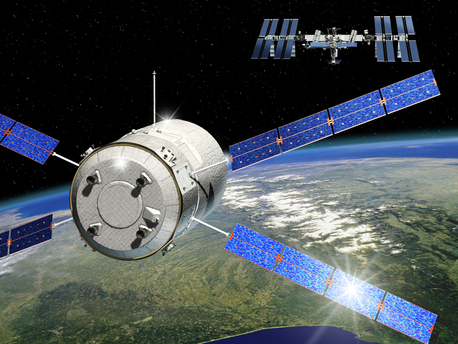ATV Johannes Kepler
Propellant and cargo for the ISS
 © ESA - D. Ducros, 2010
|
Artist's impression of the Automated Transfer Vehicle Johannes Kepler approaching the International Space Station.
Once docked to the ISS, this propellant will be used by ATV’s own thrusters to raise the Station’s orbit periodically in order to compensate for the natural decay caused by atmospheric drag.
It may also be used to move the ISS out of the way of potentially dangerous space debris that comes too close to the manned space complex.
ATV’s payload includes almost 1600 kg of dry cargo, 850 kg of propellant for Russia’s Zvezda module and 100 kg of oxygen.
Before leaving the ISS, in June, Johannes Kepler will be filled with waste bags and unwanted hardware by the crew. It will then be deorbited over the Southern Pacific Ocean and perform a controlled reentry to burn up harmlessly in the atmosphere.
Exceptionally, no drinking water will be delivered because there is already plenty aboard the ISS. The water tanks will, though, be filled with liquid waste from the Station before departure.
ATV Johannes Kepler is named after the famous German astronomer and mathematician who lived in the 16th and 17th centuries. He first depicted the movement of planetary bodies in elliptical orbits, thus paving the way for Isaac Newton’s theory of gravitation.
It is the second in a series of five spaceships developed as Europe’s contribution to the operational costs of the ISS. Astrium Space Transportation is prime industrial contractor, leading a team of more than 30 contractors in 10 European countries.
Source: ESA
ATV Johannes Kepler
Propellant and cargo for the ISS
 © ESA - D. Ducros, 2010
|
Artist's impression of the Automated Transfer Vehicle Johannes Kepler approaching the International Space Station.
Once docked to the ISS, this propellant will be used by ATV’s own thrusters to raise the Station’s orbit periodically in order to compensate for the natural decay caused by atmospheric drag.
It may also be used to move the ISS out of the way of potentially dangerous space debris that comes too close to the manned space complex.
ATV’s payload includes almost 1600 kg of dry cargo, 850 kg of propellant for Russia’s Zvezda module and 100 kg of oxygen.
Before leaving the ISS, in June, Johannes Kepler will be filled with waste bags and unwanted hardware by the crew. It will then be deorbited over the Southern Pacific Ocean and perform a controlled reentry to burn up harmlessly in the atmosphere.
Exceptionally, no drinking water will be delivered because there is already plenty aboard the ISS. The water tanks will, though, be filled with liquid waste from the Station before departure.
ATV Johannes Kepler is named after the famous German astronomer and mathematician who lived in the 16th and 17th centuries. He first depicted the movement of planetary bodies in elliptical orbits, thus paving the way for Isaac Newton’s theory of gravitation.
It is the second in a series of five spaceships developed as Europe’s contribution to the operational costs of the ISS. Astrium Space Transportation is prime industrial contractor, leading a team of more than 30 contractors in 10 European countries.
Source: ESA






